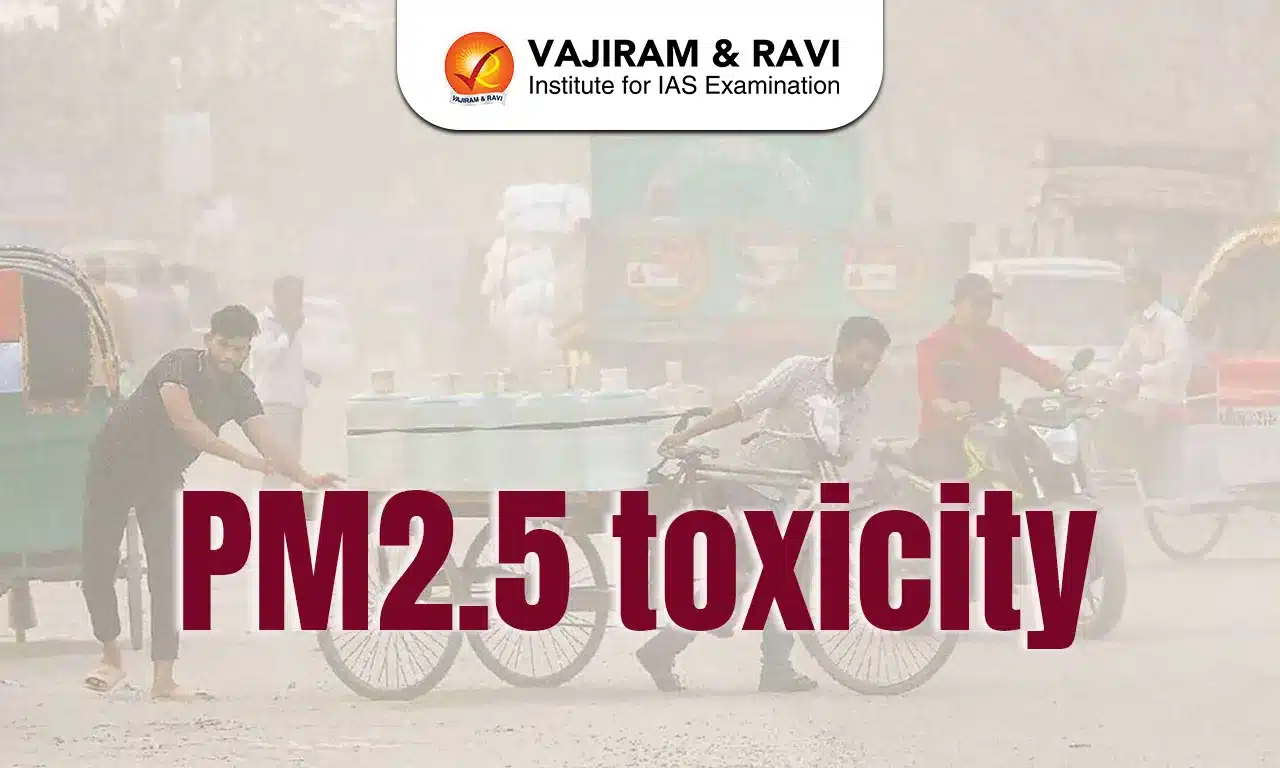PM2.5 Toxicity Latest News
- A new study conducted over Kolkata has revealed that the toxicity of PM2.5 air pollutants significantly increases after a certain concentration threshold is crossed, highlighting a sharper health hazard linked to rising pollution levels in Indian cities.
About the Study
- Title: Contrasting features of winter-time PM2.5 pollution and PM2.5-toxicity based on oxidative potential: A long-term (2016–2023) study over Kolkata megacity at eastern Indo-Gangetic Plain
- Published in: Science of the Total Environment, December 2024
Significance
- First-of-its-Kind in India: This is the first study to assess how PM2.5 toxicity varies with concentration levels in an Indian city.
- Public Health Implications: The findings call for urgent pollution control measures, especially in winter when PM2.5 levels peak.
- Policy Insight: Could guide threshold-based interventions and health advisories in Indian cities facing high air pollution.
Key Findings of the Study
- Threshold Level Identified: The study found that PM2.5 toxicity sharply increases once the concentration exceeds 70 µg/m³.
- Peak Toxicity Range: The toxicity continues to rise until the concentration hits 130 µg/m³, after which it stabilises.
- No Safe Limit: Even at concentrations below 70 µg/m³, PM2.5 poses health risks, though less severe compared to higher levels.
- Variation Expected: Thresholds for a sharp rise in toxicity are likely to differ across cities.
- This is because pollution sources vary — for example, vehicular emissions might dominate in one city, while biomass burning could be a bigger factor in another.
Why Toxicity Rises Sharply Beyond a Threshold
- At lower PM2.5 concentrations, the human body can manage the adverse effects of pollutants more effectively.
- However, beyond a certain threshold (~70 µg/m³ for Kolkata), the body’s natural defence mechanisms become overwhelmed, leading to significantly greater cellular damage, especially in the respiratory system.
Role of Reactive Oxygen Species (ROS)
- Immune Response: When pollutants are inhaled, the immune system releases Reactive Oxygen Species (ROS) to combat foreign particles.
- Double-Edged Sword: ROS can also harm healthy cells in the body.
- Antioxidants as Defenders: To counteract ROS, the body generates antioxidants, which neutralize ROS and protect cells.
- Oxidative Stress: When pollutant levels are high, ROS production exceeds the body’s antioxidant capacity, leading to oxidative stress, which damages internal cells.
Understanding Oxidative Stress and PM2.5
- The sharp rise in oxidative stress at PM2.5 levels beyond 70 µg/m³ is mainly due to chemical components from biomass or solid waste burning.
- Vehicular emissions also contribute, but to a lesser extent compared to biomass burning.
Need for Oxidative Stress-Based Standards
- While India has set air quality standards for PM2.5 and PM10, there are no benchmarks for toxicity or oxidative stress.
- This study aims to establish toxicity-based threshold values, helping cities adopt more health-focused pollution control policies.
Current Air Quality Standards: Concentration-Based
- In India, air quality standards for PM2.5 are based only on concentration levels, not on how toxic the air is.
Safe Limits
- Annual average: 40 µg/m³
- Daily average: 60 µg/m³
Limitations of Concentration-Based Standards
- Health risks depend not just on how much PM2.5 is present, but also on its chemical composition and toxicity.
- The same concentration may be more harmful in one city than another, depending on the pollutant source (e.g., biomass burning vs. vehicular emissions).
Why Toxicity Matters More
- In Kolkata, PM2.5 levels of 50–60 µg/m³ may not be significantly more harmful than 30–40 µg/m³.
- But toxicity spikes sharply after 70 µg/m³, indicating a real health emergency.
Need for Toxicity-Based Air Quality Standards
- This study strengthens the case for incorporating toxicity thresholds into air quality norms.
- City-specific thresholds should be developed, reflecting local pollutant profiles.
- Such standards could help trigger early warnings or emergency actions when toxicity crosses a critical level, even if concentrations seem “moderate.”
PM2.5 Toxicity FAQs
Q1. What is PM2.5 toxicity?
Ans. It refers to the harmful effects of fine particulate matter based on its chemical composition, not just concentration.
Q2. Why does PM2.5 become more toxic after 70 µg/m³?
Ans. Because the body’s antioxidant defences are overwhelmed, leading to oxidative stress and increased cellular damage.
Q3. What causes oxidative stress from PM2.5?
Ans. High pollutant levels trigger excessive reactive oxygen species (ROS), which damage cells when antioxidants are insufficient.
Q4. Are India’s air quality standards based on toxicity?
Ans. No, current standards are based only on concentration, ignoring the pollutant’s chemical toxicity and health impact.
Q5. What policy change does the study suggest?
Ans. It recommends city-specific, toxicity-based air quality thresholds to better assess and respond to health risks.
Last updated on November, 2025
→ Check out the latest UPSC Syllabus 2026 here.
→ Join Vajiram & Ravi’s Interview Guidance Programme for expert help to crack your final UPSC stage.
→ UPSC Mains Result 2025 is now out.
→ UPSC Notification 2026 is scheduled to be released on January 14, 2026.
→ UPSC Calendar 2026 is released on 15th May, 2025.
→ The UPSC Vacancy 2025 were released 1129, out of which 979 were for UPSC CSE and remaining 150 are for UPSC IFoS.
→ UPSC Prelims 2026 will be conducted on 24th May, 2026 & UPSC Mains 2026 will be conducted on 21st August 2026.
→ The UPSC Selection Process is of 3 stages-Prelims, Mains and Interview.
→ UPSC Result 2024 is released with latest UPSC Marksheet 2024. Check Now!
→ UPSC Prelims Result 2025 is out now for the CSE held on 25 May 2025.
→ UPSC Toppers List 2024 is released now. Shakti Dubey is UPSC AIR 1 2024 Topper.
→ UPSC Prelims Question Paper 2025 and Unofficial Prelims Answer Key 2025 are available now.
→ UPSC Mains Question Paper 2025 is out for Essay, GS 1, 2, 3 & GS 4.
→ UPSC Mains Indian Language Question Paper 2025 is now out.
→ UPSC Mains Optional Question Paper 2025 is now out.
→ Also check Best IAS Coaching in Delhi
Tags: pm2.5 toxicity

















